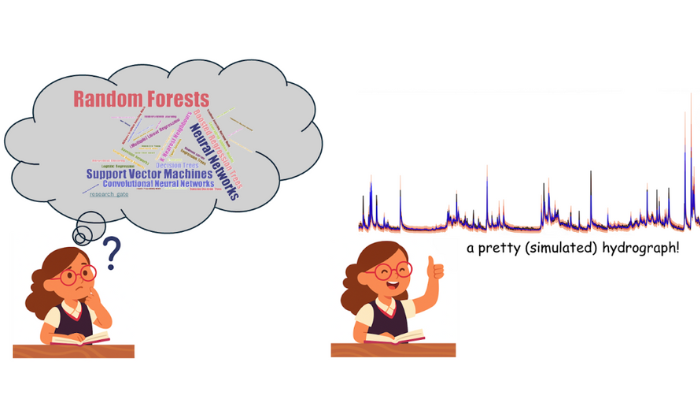
Keeping up with current Machine Learning (ML) developments in hydrology can seem like a never-ending game of catch-up! Instead of drowning yourself in a heap of scientific publications, here are a few practical hints to help you stay ahead in the ever-evolving intersection of ML and hydrology.
Hint 1: Surround Yourself with Experts and Like-Minded ML Enthusiasts
When questioned about how they keep up with the latest ML developments, “speaking with experts” sprung as an almost involuntary response from my peers. Ironically, engaging with (human) experts and researchers remains one of the most effective ways to stay updated about ML.
Conversations with peers and specialists help filter through the vast ocean of information, making it easier to focus on themes relevant to your research ecosystem. More often than not, even senior and highly-cited researchers are very approachable. And what’s better than learning from experts themselves?
Hint 2: Be a Jack of All Developments and a Master of a Few
Since you have made your way to this blog, scientific publishing is presumably a familiar territory for you. However, not all publications require the same level of attention. Developing the skill to efficiently differentiate between these will make you an ML ninja in hydrology.
At times, briefly skimming studies suffices to get acquainted with the proposed idea. Some research, on the other hand, calls for a thorough read and even some hands-on implementation. A smart approach is to set aside a fixed amount of time, regularly, to stay updated without feeling overwhelmed.
Hint 3: Set a Thief to Catch a Thief – Use AI to Your Advantage
Harness the potential of Artificial Intelligence (AI) and other ML-based tools to track down the latest and most relevant research.
AI-powered answer engines are not only equipped to retrieve information, but ChatGPT, Gemini, Claude, or Copilot all have their unique style, so don’t hesitate to use them as your little helpers!
Can’t get on top of a paper? Ask AI to summarize. Encounter a text full of mysterious new terminology? Let AI explain them to you. Don’t know how to code something/ have errors in your code? Throw it at AI.
Using Chatbots allows you to sieve through the endless sea of information quickly, and what’s best: they are (mostly) free to use. So apply them to your advantage! But remember to always obey scientific integrity, so beware of overusing when writing texts.
Hint 4: Learn from YouTube – Your On-Demand Classroom
You are never too old to skip the conventional classroom and turn to the ultimate modern-day guru: YouTube! A variety of channels offer structured content, guiding you from the basics of ML to coding complex models.
These resources help reinforce your understanding by providing accessible and engaging explanations of the fundamental methodologies behind the latest developments. A few of my personal favorites are StatQuest with Josh Starmer, 3Blue1Brown, Machine Learning Street Talk and MIT Introduction to Deep Learning.
A well-chosen newsletter delivers relevant updates without requiring you to actively search for them, saving time and ensuring that important advancements don’t slip through the cracks.
Hint 5: Master the basics and get Hands-On Experience with Repositories Like Neural Hydrology and Hy2DL
While the field progresses rapidly, it is crucial to master its basics. Efforts made to understand and implement by hand, basic ML concepts and neural network architectures, surely pay great dividends in the long term.
Platforms like Neural Hydrology and Hy2DL provide access to cutting-edge models, allowing you to experiment, implement, and deepen your understanding of ML applications in hydrology. These repositories offer pre-trained models, datasets, and tutorials that help bridge the gap between theory and practice.
Coding from scratch does not only instil confidence, but is also fundamental in understanding the theoretical underpinnings of a model. Though coding a simple LSTM network might not seem very attractive, the experience is essential – only then can you make meaningful advances in your research.
Additionally, contributing to open-source projects or developing custom implementations based on these frameworks can significantly enhance your skill set and keep you at the forefront of advancements in the field.
Final Thoughts

In conclusion, keeping up with ML developments in hydrology need not be daunting. With a multifaceted approach, you can endeavor to be on top of everything new and even push interdisciplinary research. By integrating a combination of the above tricks, you can stay ahead of the curve and make meaningful contributions to the fast evolving field of ML in hydrology.
Image sources (part of header image): Stupariu, Mihai Sorin & Cushman, Samuel & Pleșoianu, Alin & Stupariu, Ileana & Fürst, Christine. (2022). Machine learning in landscape ecological analysis: a review of recent approaches. Landscape Ecology. 37. 10.1007/s10980-021-01366-9.


Hanoch Lavee
Dear Sanika Baste, Ralf Loritz and Benedikt Heudorfer,
My name is Hanoch Lavee and I am Professor Emeritus at Bar-Ilan University, Israel. For more details, see below.
I was impressed by the post on machine learning.
During my scientific work in arid and semi-arid regions, where overland flow on hillslopes is a quick response to rainfall events and is the dominant factor in the development of floods, I have come to a number of insights that until now have been difficult for me to prove on an experimental basis. It seems to me that now, with the help of machine learning and AI methodologies, it is possible to make progress in proving these insights.
If you, or any of you, are interested in collaborating in this context – please write to me.
Best regards,
Hanoch Lavee
Hanoch.lavee@gmail.com
HANOCH LAVEE
Hanoch Lavee is a Professor Emeritus of Geomorphology at Bar-Ilan University, Israel. His research is focused on rainfall-runoff-erosion relationships, hillslope processes in Arid and semi-arid areas, overland flow discontinuity, source–sink relationships along climatic transects, the resilience of eco-geomorphic systems, and desertification under climate change.
He founded the Laboratory of Geomorphology and Soil at his university. He coordinated about 20 research projects funded by competitive research grants on Soil-Vegetation-Erosion Relations under Climate Change, Fire Effects on Runoff and Erosion, Ecosystem Desertification along a Climatological Transect, etc.
He acted as a member of task teams of several IGU commissions on specific issues, and as a member of the Editorial board of scientific journals such as CATENA, Land Degradation and Development, and LAND.
He spent periods in sabbaticals or as a visiting scientist at the London School of Economics, the Catholic University of Leuven, the University of Amsterdam, the University of Aix-en-Provence, and the University of Malaga.
Prof. Lavee supervised almost thirty graduate students for master’s and doctoral studies, and published several books, about 120 scientific articles in refereed journals, and over 120 abstracts in international conference abstracts.
He served as the president of the Israel Geographical Association and chairman of the Committee for Curriculum in Geography of the Ministry of Education of Israel.
He acted as a Dean, the Rector of his university, and President of the Kinneret College on the Sea of Galilee.
Ayu unissula
A very insightful and refreshingly practical read—thank you! This article offers an encouraging roadmap for navigating the dynamic world of ML in hydrology. The blend of expert advice, hands-on strategies, and accessible tools like YouTube and AI chatbots is both inspiring and empowering. Grateful for these thoughtful tips—definitely bookmarking this
Regard Unissula